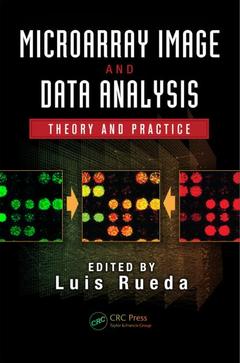Description
Microarray Image and Data Analysis
Theory and Practice
Digital Imaging and Computer Vision Series
Coordinator: Rueda Luis
Language: English
Subjects for Microarray Image and Data Analysis:
Keywords
DAT File; Regulatory Networks; CGH Array; Biclustering; SNP Array; Clustering; DNA Image; Segmentation; Microarray Images; Normalization; CEL File; Compression; DNA Microarray; Noise Treatment; Data Set; Quantification; Radon Transform; Gridding; Image Processing; Wavelet Decomposition Levels; Bioinformatics; Nucleic Acid Molecules; Microarray Tools; Diffuse Defects; Microarray Visualization; Boolean Networks; Microarray Image Analysis; DNA Damage Stimulus; Microarray Data Analysis; Parallel Coordinates; Gene Regulation; KDE; Gene Expression; Spatial Flaws; Microarrays; Exon Arrays; TMA Spot; Yeast Set; Biclustering Algorithms; Human Interactome; DNA Molecule; Time Series Gene Expression Data
Publication date: 02-2014
· 15.6x23.4 cm · Hardback
Publication date: 06-2019
· 15.6x23.4 cm · Paperback
Description
/li>Contents
/li>Readership
/li>Biography
/li>
Microarray Image and Data Analysis: Theory and Practice is a compilation of the latest and greatest microarray image and data analysis methods from the multidisciplinary international research community. Delivering a detailed discussion of the biological aspects and applications of microarrays, the book:
- Describes the key stages of image processing, gridding, segmentation, compression, quantification, and normalization
- Features cutting-edge approaches to clustering, biclustering, and the reconstruction of regulatory networks
- Covers different types of microarrays such as DNA, protein, tissue, and low- and high-density oligonucleotide arrays
- Examines the current state of various microarray technologies, including their availability and affordability
- Explains how data generated by microarray experiments are analyzed to obtain meaningful biological conclusions
An essential reference for academia and industry, Microarray Image and Data Analysis: Theory and Practice provides readers with valuable tools and techniques that extend to a wide range of biological studies and microarray platforms.
Introduction to Microarrays. Biological Aspects: Types and Applications of Microarrays. Gridding Methods for DNA Microarray Images. Machine Learning-Based DNA Microarray Image Gridding. Non-Statistical Segmentation Methods for DNA Microarray Images. Statistical Segmentation Methods for DNA Microarray Images. Microarray Image Restoration and Noise Filtering. Compression of DNA Microarray Images. Image Processing of Affymetrix Microarrays. Treatment of Noise and Artifacts in Affymetrix Arrays. Quality Control and Analysis Algorithms for Tissue Microarrays. CNV-Interactome-Transcriptome Integration. Mining Gene-Sample-Time Microarray Data. Systematic and Stochastic Biclustering Algorithms for Microarray Data Analysis. Reconstruction of Regulatory Networks from Microarray Data. Multidimensional Visualization of Microarray Data. Bioconductor Tools for Microarray Data Analysis.
Luis Rueda is professor for the School of Computer Science, University of Windsor, Ontario, Canada. Before joining the University of Windsor, he earned a Ph.D from Carleton University, Ottawa, Ontario, Canada and spent two years at the University of Concepción, Chile. A member of IEEE, the Association for Computing Machinery, and the International Society for Computational Biology, he holds three patents on data encryption, secrecy, and stealth; has published over 100 journal and conference papers; and has participated in numerous editorial and technical committees. His research is primarily focused on machine learning and pattern recognition in transcriptomics, interactomics, and genomics.
These books may interest you

Microarray Methods and Protocols 220.72 €



